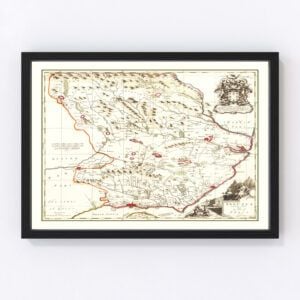Old Maps of Scotland
Take a look through our collection of Old Maps of Scotland.
Scotland is a country that is a part of the United Kingdom. The country makes up the northern section of Great Britain, and shares a border with England. There are over 790 islands included in the country of Scotland, which are mainly surrounding the archipelagos of Hebrides and the Northern Isles. Scotland is the second most populated country in the United Kingdom, holding a population of 5,463,300 inhabitants, which accounts for 8.3% of the United Kingdom’s population. A great majority of the population is situated within the Central Belt, which is the area between Scotland’s highlands and the Southern uplands.
During the Pleistocene ice ages, Scotland was covered in glaciers which can be evident upon looking at the landscape, due to its varied landscape with mountainous terrain and flatland. The geographical center of the country is home to the highest point, Ben Nevis. The mountain reaches an altitude of 1,344 meters, or 4,409 feet above sea level. The climate of Scotland is temperate and oceanic, and has been seen as very changeable. The Atlantic ocean currents give Scotland its slightly warmer temperature than any other country in the United Kingdom. Heavy snowfall is not common, however snow amounts depend on the altitude. Coastal areas average around 10 snow days per year, while Braemar, a highly elevated village, experiences 59 snow days per year.The wildlife of Scotland is very similar to any other Western European country, however large mammals have been hunted to extinction. This includes lynx, brown bears, wolves, elk, and walrus. Animals commonly found on mountaintops include ptarmigan, mountain hare, and stoat. Many animals have been reintroduced to Scotland, such as the white-tailed sea eagle, the red kite, and currently the beaver and wild boar. Scotland is home to the Fortingall Yew, which is believed to be one of the oldest trees within Europe with an estimated age of around 2,000 to 3,000 years old.
The economy of Scotland is known as a western-style open mixed economy, which is closely linked within the UK and also the outside world. Traditionally, the Scotland economy was dominated by industry, with coal mining and steel industries being some of the biggest in the world. However, during the 1970s and 1980s, focus shifted towards a more service-based economy. Scotland is known to produce textiles, whisky, shortbread, jet engines, buses, computer software, ships, and avionics. It is also known to be a powerhouse for financial services such as banking.
While the capital city is Edinburgh, the most populated city is Glasgow. When it comes to the smaller islands surrounding Scotland, only the larger ones remain populated. In fact, only under 90 of these are still inhabited. The total fertility rate of Scotland is 1.73 children per woman, which remains under the replacement rate of 2.1. Life expectancy is estimated to be 77.1 years for male citizens and 81.1 years for women. This is shockingly the lowest out of the four countries within the United Kingdom.
























Old Maps of Scotland
Take a look through our collection of Old Maps of Scotland.
Scotland is a country that is a part of the United Kingdom. The country makes up the northern section of Great Britain, and shares a border with England. There are over 790 islands included in the country of Scotland, which are mainly surrounding the archipelagos of Hebrides and the Northern Isles. Scotland is the second most populated country in the United Kingdom, holding a population of 5,463,300 inhabitants, which accounts for 8.3% of the United Kingdom’s population. A great majority of the population is situated within the Central Belt, which is the area between Scotland’s highlands and the Southern uplands.
During the Pleistocene ice ages, Scotland was covered in glaciers which can be evident upon looking at the landscape, due to its varied landscape with mountainous terrain and flatland. The geographical center of the country is home to the highest point, Ben Nevis. The mountain reaches an altitude of 1,344 meters, or 4,409 feet above sea level. The climate of Scotland is temperate and oceanic, and has been seen as very changeable. The Atlantic ocean currents give Scotland its slightly warmer temperature than any other country in the United Kingdom. Heavy snowfall is not common, however snow amounts depend on the altitude. Coastal areas average around 10 snow days per year, while Braemar, a highly elevated village, experiences 59 snow days per year.The wildlife of Scotland is very similar to any other Western European country, however large mammals have been hunted to extinction. This includes lynx, brown bears, wolves, elk, and walrus. Animals commonly found on mountaintops include ptarmigan, mountain hare, and stoat. Many animals have been reintroduced to Scotland, such as the white-tailed sea eagle, the red kite, and currently the beaver and wild boar. Scotland is home to the Fortingall Yew, which is believed to be one of the oldest trees within Europe with an estimated age of around 2,000 to 3,000 years old.
The economy of Scotland is known as a western-style open mixed economy, which is closely linked within the UK and also the outside world. Traditionally, the Scotland economy was dominated by industry, with coal mining and steel industries being some of the biggest in the world. However, during the 1970s and 1980s, focus shifted towards a more service-based economy. Scotland is known to produce textiles, whisky, shortbread, jet engines, buses, computer software, ships, and avionics. It is also known to be a powerhouse for financial services such as banking.
While the capital city is Edinburgh, the most populated city is Glasgow. When it comes to the smaller islands surrounding Scotland, only the larger ones remain populated. In fact, only under 90 of these are still inhabited. The total fertility rate of Scotland is 1.73 children per woman, which remains under the replacement rate of 2.1. Life expectancy is estimated to be 77.1 years for male citizens and 81.1 years for women. This is shockingly the lowest out of the four countries within the United Kingdom.
